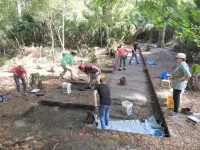(Press-News.org) Decisions made now will determine whether economies win or lose money as the coal industry changes over the next couple of decades.
Countries including Australia and Indonesia could lose billions of dollars if they continue to invest in new coal mines and exports as the world moves away from fossil fuels.
These are the conclusions of a new analysis led by a team from Imperial College London and including researchers from Queen Mary University of London and Deloitte, which is published today in the journal Joule.
The team combined data on coal resources and demand in an economic model of trade and prices. They modelled the risk of 'stranded assets' for coal investment under different decarbonisation scenarios: business as usual, where investment in coal mining and consumptions continues as it does today, and a sustainable pathway where coal consumption is reduced in line with keeping global heating to well below 2°C.
Following the sustainable pathway results in a third of today's coal mines becoming stranded assets by 2040. This means these assets become economically unviable before their operating lifetime ends, and have to be scrapped. This will cause coal-producing nations such as Australia and Indonesia to lose vital export revenues and jobs as international trade shrinks. For example, Australia could lose $25 billion per year in this scenario, and globally 2.2 million jobs could be at risk.
However, these losses are avoidable, say the authors, if financial institutions and governments prepare for the change. This could include divesting early from coal to prevent locking in future development, and by funding the retraining of coal workers.
Lead researcher Dr Iain Staffell, from the Centre for Environmental Policy at Imperial: "This is not to say that not all new coal investments - such as the deep mine planned Cumbria - will be unprofitable, but investors must carefully assess the financial as well as reputational and environmental risks when pursuing new coal mining projects."
For many world regions there are great economic benefits to phasing out coal. China, Europe and India would save money under the sustainable pathway, as they face reduced costs from importing less coal. Europe, for example, could gain $20 billion per year as coal is phased out.
Overall, the researchers estimate the sustainable pathway gives a global net saving of $10 billion per year by 2040 from reduced coal transportation costs, on top of the economic savings from reduced air pollution and health consequences.
Importantly, the authors say that under the business-as-usual scenario many more economies are likely to be losers: the longer the world waits to phase out coal, the more extreme the measures to reduce carbon emissions will need to be, leading to more stranded assets and job losses in the long run.
Dr Staffell said: "Businesses have a limited window of opportunity to get out in front of the sweeping changes that face the coal industry. We must build the human and financial resilience so that workers do not lose out, and make the transition to a coal-free world easier.
"The financial and job losses are small on a global scale, but they will be heavily concentrated in mining regions, meaning some developing economies, like Indonesia, will disproportionately suffer if the transition isn't managed carefully. When economic and job losses start to happen it will be too late - we need to start preparing for these changes now."
The mining and consumption of coal is being rapidly phased out in many Western nations, but global coal consumption is rising, especially in Asia, which is home to three-quarters of all new coal power plant capacity.
China opened many new coal mines in the 2000s, which have a lifetime of about 30 years. The decisions countries like China and India make in the coming years around whether they continue to mine and consume coal will have a huge impact on the global trajectory, say the team.
Similarly, India's energy consumption is booming, and if new coal capacity is built to meet demand rather than renewables, the world will be locked into more decades of coal trade and consumption, negatively affecting both the climate and the global economy.
First author Thomas Auger undertook the analysis as part of his MSc in Environmental Technology in the Centre for Environmental Policy at Imperial in partnership with Deloitte, which provided him access to coal market data. He said: "The wealth of knowledge from the combination of academia and industry provided us with an unprecedented opportunity to analyse not just the global situation over the next 20 years, but also how individual countries would fare.
"Our analysis shows there will be big winners and losers from this transition, but the future is not set in stone. The more governments anticipate the green transition, the more its impacts in terms of economic stability and disruption to people's livelihoods would be minimised."
INFORMATION:
BOSTON -- Death rates from chronic conditions like lung disease and cardiovascular disease and so-called "diseases of despair" such as opioid overdoses are known to be higher in rural areas than in large cities, with differing economic, social and political circumstances influencing people's access to care. To examine disparities in mortality rates for all causes of death, researchers from Brigham and Women's Hospital used a Centers for Disease Control and Prevention (CDC) database to analyze all deaths occurring in the U.S. between 1999 and 2019. They found that age-adjusted mortality rates (AAMRs) declined in both rural and urban populations, but that the gap between the death rates dramatically widened as white individuals aged 25 to ...
Amyotrophic lateral sclerosis (ALS) is a severe, fatal neurodegenerative disorder causing loss of motor neurons and voluntary muscle action. While mouse studies have identified potential treatments, these drugs have typically done very poorly in human trials. Researchers at Boston Children's Hospital, working in collaboration with Pfizer, now report a high-throughput target and drug discovery platform using motor neurons made from ALS patients. Using the platform, they confirmed two known targets and identified an existing class of drugs -- agonists to the dopamine D2 receptor -- as potential novel treatments.
The researchers, led by Clifford Woolf, MD, PhD, director of the F.M. Kirby Neurobiology Center at Boston Children's, and first authors Xuan Huang, PhD, and Kasper Roet, PhD, ...
A multidisciplinary team led by researchers from the Spanish Research Council (CSIC) identifies the genomic cellular map associated with hippocampal sclerosis, a major histopathological condition of temporal lobe epilepsy. The study, published in Cell Reports, identifies cell-type specific transcriptional signatures of hyper-excitability and neurodegeneration, providing grounds for improved diagnosis. While the presence of sclerosis is essential for identifying temporal lobe epilepsy (the most common form of drug-resistant epilepsy), it is also detected in some cases of dementia associated ...
Since March 2020 the Cancer Genomics and BioComputing of Complex Diseases Laboratory at the Azrieli Faculty of Medicine of Bar-Ilan University has been dedicated to the study of COVID-19. Motivated in particular to study the evolution of coronaviruses, the lab, led by Dr. Milana Frenkel-Morgenstern, has characterized and compared sequences of numerous relevant viruses.
In their most recent study, published in the journal of the Federation of European Biochemical Societies (FEBS), the research team focused on patterns of genetic coding used by viruses which infect a single or narrow range of hosts compared to those which infect a multiple or broad range of hosts.
It was discovered that "promiscuous", or multiple-host, viruses utilize significantly non-optimal codons (the DNA ...
Mobility analyses show: Only a small proportion of all vehicles are responsible for the majority of the kilometers driven. We are talking above all about long-distance trucks that transport goods all over Europe. If these continue to be fueled with fossil energy, it will hardly be possible to sufficiently reduce CO2 emissions in road traffic. Synthetic fuels from surplus renewable electricity can make a significant contribution to such frequent driver applications.
With electric mobility, hydrogen mobility and synthetic fuels, Empa's future mobility demonstrator, "move", is investigating ...
In a first-of-its-kind study, researchers from Tel Aviv University and the Academic College of Tel Aviv-Yaffo used smart watches and a dedicated app to monitor 169 subjects before and during Israel's second COVID-19 lockdown (October 2020). The watches and app provided the researchers with accurate daily data for measuring quality of life parameters, such as mood, stress, duration and quality of sleep, heart rate at rest, meeting others and physical exercise.
The study was conducted by a group of experts from the Iby and Aladar Fleischman Faculty of Engineering at Tel Aviv University led by Dr. Erez Shmueli, Dr. Dan Yamin, Shay Oved and Merav Mofaz, in collaboration with TAU's Prof. Noga Kronfeld Schor of the School of Zoology at the George S. Wise ...
BOSTON - Last year, people who smoked had a variety of responses to the COVID-19 pandemic, with some increasing their smoking to help them cope and others quitting to potentially lessen their vulnerability to COVID-19. That's the finding of new research published in the Journal of General Internal Medicine and conducted by investigators at Massachusetts General Hospital (MGH), Vanderbilt University Medical Center and the University of Pittsburgh School of Medicine.
"Studies have shown that alcohol and opioid use increased during the pandemic, but little is known about how smokers responded," says lead author Nancy A. Rigotti, MD, director of MGH's Tobacco Research and Treatment Center and professor of Medicine at Harvard Medical School. "They might have increased ...
Rising temperatures are increasingly affecting the quality of life in many regions, setting new challenges for architects, urban planners and healthcare systems. Researchers at KAUST have analyzed discomfort due to outdoor heat across Saudi Arabia and neighboring regions to help understand and combat the problem.
"Living conditions in the Kingdom have been particularly affected by the changing climate," says Hari Dasari, first author of the paper. He also emphasizes the unique challenges facing the Hajj pilgrimage visits by several million people each year. Between 2014 and 2018, the Hajj occurred in summer months when the ...
UNF archaeology researchers are uncovering the lost Indigenous NE Florida settlement of Sarabay
Jacksonville, Fla. - The University of North Florida archaeology team is now fairly confident they have located the lost Indigenous northeast Florida community of Sarabay, a settlement mentioned in both French and Spanish documents dating to the 1560s but had not been discovered until now.
The type and amounts of Indigenous pottery the team is finding combined with the type and dates for European artifacts as well as cartographic map evidence strongly supports this location as the late 16th/early 17th century Mocama settlement.
The researchers have opened large excavation blocks with many exciting ...
The "miracle of life" is most obvious at the very beginning: When the fertilized egg cell divides by means of furrows into blastomeres, envelops itself in an amniotic sac, and unfolds to form germ layers. When the blastomeres begin to differentiate into different cells - and when they eventually develop into a complete organism.
"We wanted to find out whether the later differences between the various cells are already partly hard-wired into the fertilized egg cell," says Dr. Jan Philipp Junker, who heads the Quantitative Developmental Biology Lab at the ...





